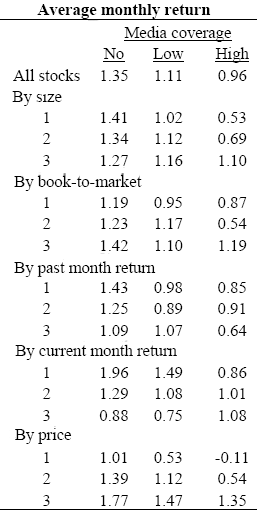How does main-stream media (MSM) coverage of companies relate to returns on their stocks? Does coverage reduce risk by disseminating information? In their February 2007 paper entitled “Media Coverage and the Cross-Section of Stock Returns”, Lily Fang and Joel Peress examine how media coverage (Wall Street Journal, New York Times, USA Today and Washington Post) relates to stock returns. Using article counts and other data (on trading, accounting, analyst coverage and ownership) for all NYSE-lilsted companies and 500 randomly selected Nasdaq-listed companies over the period 1993-2002, they find that:
- In a typical year, 25% (58%) of NYSE-listed (Nasdaq-listed) companies have no media coverage. There is considerable overlap in companies covered across newspapers. A relatively few companies account for much of the coverage. For a given company, persistence of coverage or non-coverage from month to month is high.
- Media coverage relates positively to firm size and analyst following. It does not relate significantly to valuation measures (book-to-market ratio) or stock return momentum.
- On average, stocks with no media coverage outperform stocks with high media coverage, rebalanced monthly, by 0.23% per month (3% per year) after adjusting for market, size, book-to-market, momentum and liquidity factors.
- For small stocks, stocks with low analyst following and stocks with low institutional ownership, the risk-adjusted “ignored-by-the-media” return premium is 0.65%-1% per month (8%-12%) per year.
- Of the four newspapers, the Wall Street Journal contributes most strongly to the premium.
- Results are generally robust to portfolio formation/holding periods and to type of news.
- Information risk (not illiquidity or investor irrationality) is the most likely explanation for this premium.
The following table, excerpted from the paper, summarizes the relationships between last-month newspaper coverage (number of articles) and average equally-weighted next-month stock returns (%) according to various firm characteristics: size, book-to-market, current and past month returns and price. In each case, the factor sortings are 1=low, 2=medium and 3=high. It shows that less media coverage, on average, almost always means higher stock returns.

In summary, there is an “information risk premium” such that stocks not covered by the news media yield significantly higher future returns than stocks heavily covered, even after accounting for other widely used risk factors.
Do Internet-driven changes in information dissemination processes affect this premium?